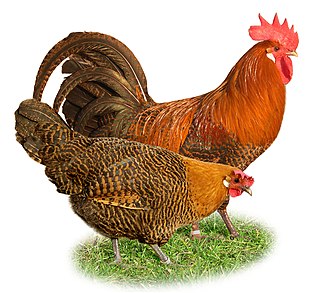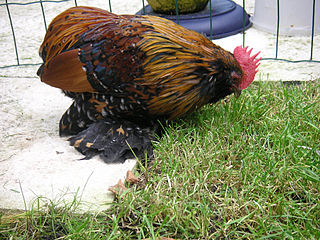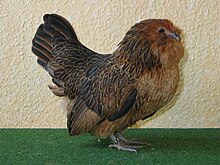
The Braekel or Brakel is a traditional Belgian breed of chicken. It is thought to have originated in the area of Brakel, in the Flemish province of East Flanders, for which it is named. There is a bantam version of the Braekel. The Campine of the United Kingdom derives from it.

The Sussex is a British breed of dual-purpose chicken, reared both for its meat and for its eggs. Eight colours are recognised for both standard-sized and bantam fowl. A breed association, the Sussex Breed Club, was organised in 1903.

The New Hampshire Red or New Hampshire is an American breed of chicken. It was developed in the early twentieth century in the state of New Hampshire by selective breeding of Rhode Island Red stock; no other breed was involved. It is fast-growing, early-maturing, quick-feathering, and yields a meaty carcass. Mature birds are a light or medium red in color; they may fade in sunlight.

The Barbu d'Uccle or Belgian d'Uccle, Dutch: Ukkelse Baardkriel, is a Belgian breed of bearded bantam chicken. It was first bred in the town of Uccle on the outskirts of Brussels, in central Belgium, in the early years of the twentieth century. It is a true bantam, with no standard-sized large fowl counterpart, and is one of eleven Belgian true bantam breeds.

The Sebright is a British breed of bantam chicken. It is a true bantam – a miniature bird with no corresponding large version – and is one of the oldest recorded British bantam breeds. It is named after Sir John Saunders Sebright, who created it as an ornamental breed by selective breeding in the early nineteenth century.

The Campine is a breed of domestic chicken originating in the northern part of Belgium. It is named for the Campine region of north-eastern Belgium and south-eastern Netherlands. It was known there as the Kempisch Hoen.

The Booted Bantam or Dutch Booted Bantam is a European breed of true bantam chicken. It is characterised by abundant feathering on the feet and shanks, which gives it a "booted" appearance; and by vulture hocks, long stiff downward-pointing feathers on backs of the thighs, from which the Dutch name Sabelpoot ("sabre-legged") derives.

The Barbu d'Everberg, is a Belgian breed of bantam chicken. It is a tailless variant of the Barbu d'Uccle, and was bred in about 1906 at the Château d'Everberg, at Everberg in the municipality of Kortenberg, between Brussels and Leuven. It is among the most endangered chicken breeds in Belgium, and in 2010 its conservation status was classed as "critical". It is a true bantam, with no large counterpart. Cocks weigh 700–800 grams, and hens 550–650 g.

The Fayoumi or Egyptian Fayoumi also known in Egypt as Bigawi is an Egyptian breed of chicken. It originates from – and is named for – the governorate of Fayoum, which lies south-west of Cairo and west of the Nile. It is believed to be an ancient breed.

The Barbu de Watermael, Dutch: Watermaalse Baardkriel, is a Belgian breed of bantam chicken. It originated in the Belgian town of Watermael-Boitsfort, from which it takes its name, which means "bearded [chicken] from Watermael". It is closely related to the Barbu d'Anvers, but is distinguished from it by its small, backswept crest of feathers as well as its triple spiked rosecomb. The Barbu de Boitsfort is a rumpless variation, the only difference being that it lacks the uropygium, the part of the anatomy that carries the tail.
The Rumpless Game is a British breed of tail-less chicken. It may have originated on the Isle of Man, and may thus be known as the Manx Rumpy. There are both standard-sized and bantam Rumpless Game.

The Brabanter is a Dutch breed of crested chicken originating in the historic region of Brabant which straddles Belgium and the Netherlands. It is an ancient breed and is shown in 17th-century paintings. A bantam Brabanter was created in around 1934.
The Barbu de Grubbe, Dutch: Grubbe baardkriel, is a Belgian breed of bantam chicken. It is a true bantam, and has no full-sized counterpart; males weigh about 700 grams and hens about 600 g. It is a tail-less variant of the Barbu d'Anvers, and is otherwise similar to it in every respect. The same colour varieties are accepted for the Barbu de Grubbe as for the Barbu d'Anvers.
The Belgian Bantam, Dutch: Belgisch kriel, French: Naine belge, is a breed of bantam chicken from Belgium. It is a true bantam, and has no full-sized counterpart; cocks weigh about 650 grams and hens about 550 g. It is in danger of extinction; in 2010 a total of 168 birds were counted in the whole of Belgium. Fourteen colour patterns are recognised in the European standard.

The Ardennaise, French: Poule ardennaise, is a breed of domestic chicken from the Ardennes plateau, in Belgium and eastern France. Its range extends from the Pays de Herve in Wallonia to the French département of Ardennes, and includes the Fagnes, the Famenne, and the valleys of the Amblève, the Ourthe and the Semois.
The Barbu de Boitsfort or Dutch: Bosvoordse Baardkriel is a breed of true bantam from Belgium. It is a tail-less variety of the Barbu de Watermael, and is otherwise similar to it in every respect. It is named for the commune of Watermael-Boitsfort in the Brussels region of Belgium.
The Bassette Liégeoise or Bassette is a breed of large bantam chicken from Belgium. It is larger than most bantams, but much smaller than full-sized breeds; cocks weigh about 1000 grams and hens about 900 g. Like most Belgian bantam breeds, it is in danger of extinction. Eighteen colour patterns are officially recognised; many of them are rare.
The Pictave is an endangered French breed of bantam chicken. It is named for the Pictavi, the tribe which gave its name to the former Province of Poitou, now part of the region of Nouvelle-Aquitaine. It is a true bantam, and has no full-sized counterpart; it is the only true bantam of France. Cocks weigh about 800 grams and hens about 600 g. It was created in the twentieth century by Raymond Lecointre, who used the hens to incubate his pheasant eggs and raise the chicks.

The Malines, Dutch: Mechelse Koekoek, is a Belgian breed of large domestic chicken. It originates from the area of Mechelen, in the province of Antwerp in Flanders, for which it is named. It was created in the nineteenth century by cross-breeding local cuckoo-patterned farm chickens with various different types of imported Oriental chicken. With the Jersey Giant, it is among the heaviest of all chicken breeds. It is valued for the quality of its meat, which is pale in colour and fine-textured.













